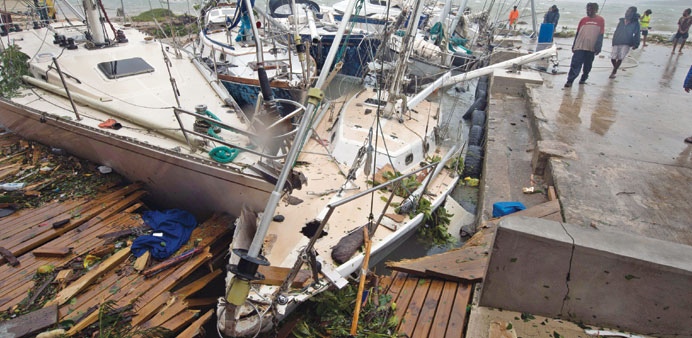AFP/Suva
Vanuatu’s president has made an emotional appeal for international assistance after his island nation was hit by a calamity of a cyclone, wreaking devastation in what is feared to be one of the region’s worst weather disasters.
Though the full extent of the damage is unknown, the UN had unconfirmed reports of 44 people killed in just one province while aid agencies described scenes of destroyed homes, downed trees and blocked roads as a result of Super Cyclone Pam, a maximum category five storm.
Media including the Wall Street Journal cited the country’s Disaster Management Office in saying that six people were killed and a state of emergency declared over the tropical cyclone, which had gusts of up to 320kph (200mph).
Vanuatu’s President Baldwin Lonsdale led appeals for international assistance, telling delegates at a UN conference on disaster risk reduction in Japan that he spoke with a “heart that is so heavy”.
“I stand to appeal on behalf of the government and people of Vanuatu to the global community to give a lending hand in responding to these very current calamities that have struck us,” Lonsdale said. “Fellow heads of state, governments, and development partners, we have all experienced a form of disaster at one time or another. Today we appeal for your assistance.”
Aid agencies were scrambling for information and preparing to send teams to Vanuatu, whose main island is home to more than 65,000 people, with a UN disaster assessment and co-ordination team expected to arrive late today.
NGOs have also launched appeals and are hoping to start flying in emergency supplies of food, shelter and medicine from today, when the airport in the capital Port Vila is expected to reopen.
Australia offered assistance and said medical and search and rescue staff were on standby.
Donations included $2.9mn from Britain, $733,750 by New Zealand and $1.05mn from the European Union.
“A disaster of this magnitude has not been experienced by Vanuatu in recent history – particularly in terms of the reach of the potential damage and the ferocity of the storm,” said Sune Gudnitz, who heads the United Nations Office for the Co-ordination of Humanitarian Affairs in the Pacific.
Unicef New Zealand executive director Vivien Maidaborn, meanwhile, said that “early reports are indicating that this weather disaster could potentially be one of the worst in Pacific history”.
“The sheer force of the storm combined with communities just not set up to withstand it, could have devastating results for thousands across the region,” she said.
Aurelia Balpe, head of the Pacific regional office of the International Federation of Red Cross and Red Crescent Societies, said that while there were reports of casualties in Port Vila, they had greater fears for outlying southern islands, home to more than 33,000 people, where communications had been cut.
World Vision said more than 2,000 people had already sought refuge in emergency shelters in Port Vila, but warned that it could take weeks to reach more remote islands affected by the storm.
Residents of Port Vila spent the night hunkering down as the terrifying storm raged.
“The scene here this morning is complete devastation – houses are destroyed, trees are down, roads are blocked and people are wandering the streets looking for help,” said Save the Children’s Tom Skirrow.
Unicef spokeswoman Alice Clements described the cyclone as “15-30 minutes of absolute terror” for “everybody in this country” as it passed over.
The storm crossed the main Vanuatu island and a group of islands further south after affecting the Solomon Islands and Tuvalu, where there were no reports of fatalities.
United Nations chief Ban Ki-moon, speaking from Japan, said while the impact was not yet clear, “we fear the destruction and damage would be widespread”.
France, which will host a crucial UN climate change summit in December, meanwhile said that the “tragedy once again highlights the danger posed to the planet by extreme weather events, exacerbated by climate disturbances”.
Fiji Weather Service meteorologist Neville Koop said the cyclone was weakening as it slowly moved away from Vanuatu, and would pass between Fiji and New Caledonia before brushing the North Island of New Zealand tomorrow.
Koop said that Pam was not the strongest storm ever to hit the South Pacific – Tropical Cyclone Zoe, which hit in 2002, was stronger – but that it was packing gusts of 320kph and sustained winds of 250kph.

This handout photo taken by and received yesterday from Unicef Pacific shows storm damage to boats in Port Vila.
